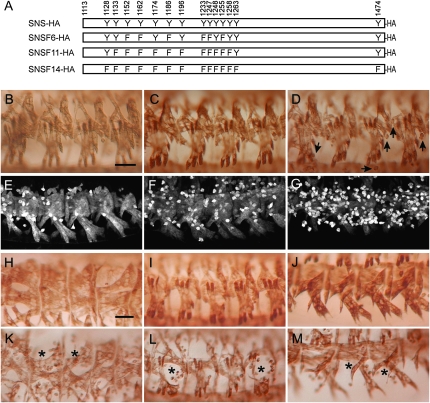Figure 6.—
Tyrosine residues in the SNS cytodomain are required for efficient myoblast fusion. (A) Schematic of the transgenes, with the positions of the substituted tyrosine residues indicated. In all cases, tyrosines were mutated to phenylalanine. (B–M) Stage-16 embryos in which the musculature has been visualized by immunostaining with an antibody to muscle myosin (B–D and H–M) and β-galactosidase (E–G). All rescued embryos are representative of results obtained using two independent transgenic lines. (B–D, F, and G) Expression of the transgene was directed to snsZf1.4/snsXB3 mutant embryos using mef2Gal4 at 25° using the transgenic lines (B) UAS-snsF6-HA, (C) UAS-snsF11-HA, (D and G) UAS-snsF14-HA, and (F) UAS-sns-HA. (E) Wild type. (E–G) Embryos also contained an sns-LacZ transgene that is expressed at a high level in unfused myoblasts and facilitates their quantitation. While these rescued embryos exhibit more unfused myoblasts than a wild-type embryo (compare F and E), significantly more unfused myoblasts are seen in embryos “rescued” with a transgene in which all cytodomain tyrosines have been mutated (G). (H–M) Embryos in which expression of the transgene was directed to snsZf1.4/snsZf1.4 mutant embryos using snsGal4 at 18°, using the transgenes (H–J) UAS-sns-HA and (K–M) UAS-snsF14-HA. The inefficiency of rescue is apparent at lower levels of expression, when large numbers of unfused myoblasts are seen in dorsolateral, lateral, and ventrolateral views of mutant embryos expressing the mutant transgene but not its wild-type counterpart. Arrows point to unfused myoblasts in D and asterisks in K–M mark regions of missing muscles. Bar, 20 μm.

